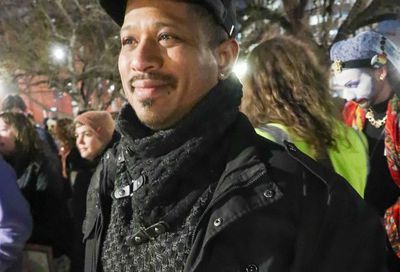How Vending Machines Can Save Lives in Substance Abuse Crisis
“Harm reduction” vending machines, offering everything from naloxone to condoms, have begun popping up in Washington, D.C.

“We lost over 500 people in D.C. last year to overdoses, both people who are intentionally using opioids and people whose drugs are laced with opioids who don’t know it,” says Alexandra Bradley, the outreach and community engagement manager for the D.C.-based harm reduction organization HIPS, Inc., which serves communities impacted by sex work and substance abuse.
“We’ve seen fentanyl show up in cocaine and methamphetamine and other drugs, which are stimulants,” notes Bradley. “So the folks using those drugs are not used to having opioids in their system. Even a little bit of a strong drug like fentanyl could easily do a lot of damage and put someone at risk. You’re also speed-balling at that point, because you’re using different kinds of drugs at the same time, which increases your risk of overdose. That’s what we saw at the beginning of this year.”
Eager to prevent deaths and serious injuries, and to promote safer behaviors when it comes to sex or drug use, officials with the DC Health, the Department of Behavioral Health, and D.C. Fire & Emergency Medical Services Department — borrowing a model that has been successfully deployed in cities like Milwaukee, Las Vegas, and New York City — proposed a new pilot program involving the use of “harm reduction” vending machines. (A similar vending machine initiative is currently being carried out in nearby Anne Arundel County, Maryland, which is home to Annapolis.)
The vending machines, which require a code to operate, contain naloxone, also known as Narcan, a nasal spray that can reverse an overdose from opioids. They also contain fentanyl test kits, which can be used to check whether drugs are laced with the potentially lethal opioid, syringes and syringe wound care kits, and “snorting kits” that include paraphernalia to aid users in snorting drugs, which carries less risk of overdose than administering drugs intravenously.
Also available are condoms, lubricants, water bottles, and snack foods like crackers and granola bars. They effectively serve as a one-stop shop for people engaged in sex work or drug use.
The vending machine pilot program, which launched last week, is funded by a grant from DC Health, which has partnered with HIPS to oversee and restock the vending machines.
DC Health has also partnered with Family and Medical Counseling Services, and Us Helping Us, People Into Living, Inc., but their machines, which are located at firehouses in Northeast, Southeast and Southwest D.C., don’t contain syringes or snorting kits, and instead offering wellness-related supplies like rapid HIV and COVID test kits, in addition to Narcan, fentanyl testing strips, and condoms.
The machines are accessible 24 hours a day, seven days a week, and have been placed in areas where there are higher concentrations of overdose deaths or in historically under-served areas of the city.
Currently, there are three functioning machines: one at the Michelle Obama Southeast Center of Bread for the City; one at Bread for the City’s Shaw location; and one at Whitman-Walker Health’s Max Robinson Center, on the campus of the former St. Elizabeth’s psychiatric hospital.
To operate the machines, individuals are asked to call 202-779-0486 — which is listed on each machine — whereupon they will receive a four-digit participant code that they can punch in, allowing them to obtain the specific items they’re seeking. The code will continue to work at any vending machine throughout the city. For those in need of Narcan or fentanyl testing strips, users can enter an emergency code of 9999, plus the pound sign, and circumvent the process of having to call and wait to receive a special code.
Each vending machine collects data on the number of users and the items that have been dispensed, which is analyzed by HIPS and other providers, who routinely restock the vending machines. There are also sharps collection bins next to each collection bin, where people can dispose of used needles.
A small number of people who obtain a code to use the machines will be invited to participate in a study, conducted by researchers from the University of Maryland, to determine the vending machine program’s efficacy. The study will also assess neighborhood perceptions of the vending machines from nearby business owners, residents, and other community members. So far, at least 150 individuals have enrolled in the program.

“When we talk about ‘harm reduction,’ one of the things we really stress and focus on is helping people stay alive and stay as safe as possible,” Bradley says. “We all do things that carry risk in our lives, and that may include drug use or sex work. So basically harm reduction is just a practice of helping people stay safer while engaging in those behaviors.”
Another risk Bradley says has become more common among those using drugs is wounds, which is why wound care packets are available.
“There has recently been the introduction of [xylazine] into the opioid supply, which is an animal tranquilizer that folks have been cutting the supply with,” they note. “It leads to even worse soft tissue damage than we see in typical injection drug users. Even if you’re not injecting it, you can still see the emergence of wounds on various parts of the body. So we see a lot of need for wound care, because folks are afraid to go to traditional hospitals or medical providers due to the stigma associated with drug use. So we’ve been teaching folks how to keep those wounds clean and bandaged up as much as possible.”
Another benefit of the vending machines, says Bradley, is that by offering needles, people can lessen their risk of HIV or hepatitis C transmission because they are not sharing needles for intravenous drug use.
In fact, says Starr O’Leary, community outreach coordinator for HIPS, the data from the machines suggests that the presence of the machines and the sharps disposal bins in neighborhoods is leading drug users to be more responsible with their medical waste.
“One of the interesting figures that our data coordinator has figured out is that more sharps have come into the disposal bins than the machines have distributed,” says O’Leary. “So not only have we made sure that sterile needles have gone out, but we’re doing a major service to the community, because for ages people have been complaining that they don’t want used sharps to be in their yards or in the street or playgrounds or places where kids have access to them. And now there is a safe place for people to dispose of them.”
Still another benefit of the machines is the easy access they can provide to condoms and barriers that can be accessed so people aren’t engaging in unprotected sex.
O’Leary notes that it’s community groups like HIPS who often do the heavy lifting that would typically be assumed by licensed medical providers or social workers. For instance, they note, medical providers may weaponize facts about a patient — like whether they have children — to justify calling police or social services.
Other clients with visible track marks on their arms have reported being denied opioids, even when not using, or treated poorly after being labeled by health professionals as “drug-seeking.” It’s HIPS employees and volunteers who may serve as a person’s only point of contact with some form of health care.
“We aren’t licensed medical professionals, but because there are so few resources available that people trust, we’re having to become street medicine providers,” they say.
Both O’Leary and Bradley say that the D.C. Council’s recent passage of the SECURE DC omnibus crime bill — and specifically a provision allowing the Metropolitan Police Department to declare areas of the city “drug-free zones” — has complicated their outreach efforts.
Under the bill’s provisions, the Chief of Police for MPD can declare public areas meeting certain criteria, and any surrounding areas up to a 1,000 foot radius around it, a drug-free zone for up to five days. Inside that drug-free zone, MPD officers can require groups of two or more people to disperse if they are believed to be congregating to engage in illicit drug activity.
Advocates claim that MPD has failed to notify DC Health, the Department of Behavioral Health, and organizations like HIPS in advance of the establishment of drug-free zones. They also claim that signage notifying people of drug-free zones remains posted far beyond the five-day period.
Bradley says some MPD officers have even begun trailing HIPS’ official van, which predates the vending machines, and typically travels to different areas of the city where people may congregate in order to offer them harm-reduction materials like naloxone or condoms. Bradley says it appears those officers are using evidence of a person’s interactions with the HIPS van as probable cause for charging people with intending to engage in illegal activity.
“We’ve actually had to stop services in the drug-free zones for the five days they’re active and find ways to gather people far enough outside the zone so they’re not visible,” they say. “That’s a huge disruption of services in those spaces. And it also puts people underground. They’re going and hiding, which means they have less access to people who can respond in the event of an overdose and who can be there in the event that something goes wrong.”
That disruption of service, O’Leary says, makes the availability of vending machines all the more important to ensure those engaging in drug use are doing so in a way that mitigates their level of risk.

The data obtained from the machines, as well as data from DC Fire & Emergency Medical Services, show that both lethal and non-lethal overdoses have fallen in the areas where the vending machines are located — indicating that the machines are having their desired effect.
“If the Council had let this program work for a little bit longer, I’m sure we could have gotten that overdose ‘heat map’ down exponentially, because these machines are doing what they are intended to do,” O’Leary says.
They note that HIPS has already received feedback from individuals using the vending machines. For example, O’Leary was recently approached by someone while restocking the HIPS vending machine in Shaw who complained that they couldn’t access the number of fentanyl testing strips they needed, prompting the organization to try and stack multiple testing strips per coil to meet the demand.
Besides the vending machines themselves, HIPS has also begun conducting training sessions for bar employees and nightlife venues on how to use Narcan. Under new city regulations, bars and clubs are allowed to have Narcan and fentanyl testing strips on site in case of an overdose, but cannot act as distribution points. Previously, some establishments had been reluctant to stock such supplies for fear that it might be used against them as an excuse to pull their alcohol or business permits.
David Perruzza, owner of the Adams Morgan-based LGBTQ bar Pitchers, told Metro Weekly in an interview prior to the regulation change, that people in the nightlife industry had been afraid of being labeled or targeted as a drug hangout. At the time, Perruzza was one of the few bar owners who was vocal in demanding that the city take opioid overdoses seriously and provide bars with Narcan to save people’s lives.
“I can’t tell you how many private messages I got, of people asking me where to get Narcan,” Perruzza said, noting that he had posted information about Narcan on his social media channels to make others more aware of the danger of drugs laced with fentanyl following several overdoses affecting individuals in the LBGTQ community.
“Everyone’s terrified to talk about it,” he said at the time. “I’m like, ‘Why are you terrified to talk about it?’ People keep fucking dying. Someone’s got to say something. If you know that people are hosting these private parties, the community should be prepared if something bad happens.”
Luckily, since the regulation change, Bradley says that more nightlife establishments have become vocal about having Narcan on site as a harm reduction measure.
“We’ve been working hard, engaging with nightlife performers and drag artists to get the word out,” they say. “This is a brand new project, and it’s sort of built from the ground up. So we’re really in the development phase. But when the regulations changed, we got so much response from bars to get the harm reduction materials in there, to get people trained on what to do if a person overdoses.”
While moralistic crusaders and “tough on crime” advocates in D.C. frequently balk at the idea of promoting harm reduction measures — whether in HIPS’ vending machines or through other means — and argue that it simply encourages people to engage in dangerous behaviors like drug use and sex work, community advocates claim that the harm-reduction approach is more effective than the hardline “Just Say No” approach that has been employed for decades.
“If people don’t want other people to be using drugs and want them to end up in recovery, we can’t help them if they’re dead,” O’Leary says matter-of-factly. “That is to say, if you want someone to reach the point in their journey where they don’t want to be using drugs or having unprotected sex anymore, it’s too late once they’re dead. And sometimes it takes people a long time to reach that point.”
“In terms of what we’re seeing with the overdose crisis, harm reduction seeks to prevent things like infectious disease transmissions or trying to prevent overdoses, or ensuring people don’t die when overdoses do happen,” adds Bradley. “In a criminalized system, where drugs operate in an underground market, and people don’t necessarily know what they’re getting, there’s risk associated with that. We’re just trying to make sure that folks can stay as safe as possible.”
Vending machines offering naloxone and other harm-reduction materials can be found at the Michelle Obama Southeast Center of Bread for the City, 1700 Marion Barry Ave. SE; at Bread for the City, at 1525 7th St. NW; and outside Whitman-Walker Health’s Max Robinson Center, at 1201 Sycamore Dr. SE.
For more information about HIPS, visit www.hips.org.
Editor’s note: An original version of the article misidentified the animal tranquilizer being introduced into some opioids, causing ulcers among drug users. The correct name is xylazine.
Support Metro Weekly’s Journalism
These are challenging times for news organizations. And yet it’s crucial we stay active and provide vital resources and information to both our local readers and the world. So won’t you please take a moment and consider supporting Metro Weekly with a membership? For as little as $5 a month, you can help ensure Metro Weekly magazine and MetroWeekly.com remain free, viable resources as we provide the best, most diverse, culturally-resonant LGBTQ coverage in both the D.C. region and around the world. Memberships come with exclusive perks and discounts, your own personal digital delivery of each week’s magazine (and an archive), access to our Member's Lounge when it launches this fall, and exclusive members-only items like Metro Weekly Membership Mugs and Tote Bags! Check out all our membership levels here and please join us today!
























You must be logged in to post a comment.